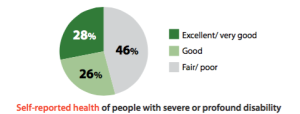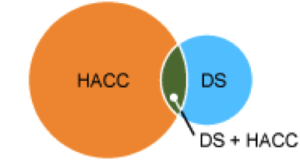Almost 1 in 5 Australians report having a disability with 1.4 million needing helping with basic daily activities.
The nature and extent of the health inequities
People with disability experience poorer health than other Australians. Nearly half of people 15-64 years old with disability report fair or worse health compared to 5% of other Australians. Within this age group people with severe or profound disability had higher rates of: young onset arthritis, osteoporosis before age 45, and young onset diabetes. People with disability also smoked more, were more overweight, and had more suicidal thoughts.
People with disability are extensive users of health services and have higher rates of consultation with GPs, specialists and other health professionals. This high use is linked with the high prevalence of multiple long-term health conditions and comorbidity of mental disorders and physical conditions.
The sociocultural, socioeconomic and environmental determinants
The sociocultural determinants of health include: family, peers, religion, media and culture. Amongst people with disability ATSI are twice as prevalent as other Australians. The elderly are also very over represented among people with disabilities. A number of disabilities are genetic, which makes family and culture very important.
Socioeconomic determinants include: education, employment and income. Some people with disabilities are limited in their access to education, requiring schools specifically designed for them. People with disabilities have lower levels of education compared to other Australians and many have a limited choice of employment. These combine to produce lower income levels for people with disabilities compared to other Australians.
Environmental determinants include: access to health services, technology, and geographical location. People with disabilities often have reduced access to health services and some require technology in order to be mobile. Often this technology comes with a cost. The government has helped to ensure people with disabilities have better access to health services ensuring every health centre, medical centre and hospital have disabled access.
The roles of individuals, communities and governments in addressing the health inequities
Individuals can be limited in their ability to change their health. Some have no choice of food or activities they are involved in. Others people with disabilities ended up there because of lifestyle choices. This means some individuals can help or at least could have helped themselves by making better more informed choices. People with disabilities should seek, where possible, to increase their education utilising the services provided for them.
Nearly half the people with disabilities utilised community support services and almost 20% used community access services. The Aging, Disability & Home Care community services include:
- Early intervention programs
- Supported accommodation
- Living skills programs
- Social groups
- Helping find employment
- Advocacy, and
- Awareness promotion
The Australian government has established a National Disability Strategy that seeks to address many of the inequities experienced by people with disabilities. The government also has DisabilityCare Australia and seeks to provide nationally consistent assessment processes, improves service standards and developing the disability workforce. The Australian government also funds many community programs and developed the Disability Support Services and the Home and Community Care Program. Many people with disabilities utilise these programs and services.



